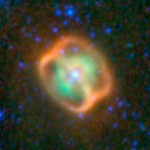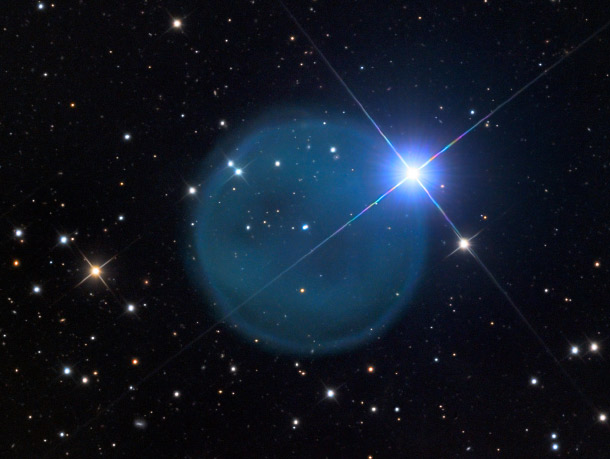Create a free profile to get unlimited access to exclusive videos, sweepstakes, and more!
An enigmatic blue bubble in space

There is something aesthetically pleasing about symmetry, whether it's on Earth or as it is in the heavens. That may be one of the reasons I love planetary nebulae, the eerie and beautiful structures created when dying stars cast off their outer layers. They come in many strange shapes, and oddly it's quite rare to find one that appears perfectly circular.
But they do exist, and one of the best examples I have seen yet is Abell 33, the glowing winds from a star located something like 1500 light years away:
How gorgeous is that? [Click to embiggen.] This image was made by BABlog regular Adam Block, using the 0.8 meter (32") Schulman Telescope at the Mount Lemmon SkyCenter. He combined images through four filters for a total observation of 630 minutes, over ten hours, to make this dream-like shot.
A few things jumped out at me. First, that bright star on the edge of it giving it a diamond-ring look is almost certainly just a chance alignment. It's probably much closer or farther away than the nebula, and coincidentally lined up. But it's very pretty!
Second, it looks like the central star may be a binary, two stars orbiting each other. I measured their separation on the image, and assuming the distance to the nebula really is 1500 light years (though that's fairly uncertain; I was surprised that there aren't many papers in the literature about this object), those two stars are no closer than about 0.03 light years from each other -- about 2000 times the distance of the Earth from the Sun! That's a long way, though not unheard of in binaries. Still, I can't rule out a coincidental alignment.
Also, it's obvious the central star(s) is off-center! That does happen, usually if the star is moving rapidly through space. The wind it expels gets "blown back" by gas in between the stars, like steam coming from an old-time train's spout as it rolls down the track. If that were the case, though, I'd expect the nebula itself to be compressed along one side, which it isn't. That's a bit of a mystery.
Third, of course, is how circular it is. The outer rim is nearly a perfect circle, which is really uncommon! You might think that in space spheres are common (which would then look like circles as seen from the outside; see here for why), but in fact that's rarely the case for planetary nebulae. Most are oval, or barrel-shaped, or something even weirder. It has to do with the way the dying star blows off winds, streams of subatomic particles from its surface. If a star is just sitting there, or rotating very slowly, then sure, the wind might expand as a sphere.
Apparently, though, for most stars something happens to increase their spin before they become planetary nebulae. One thing that could do it would be planets: big planets orbiting the star close in would get swallowed up as the star expands into a red giant (the first step in becoming a planetary nebula). The planet orbits the star faster than the star itself spins, so the planet acts like an egg beater or a whisk, stirring up the star's insides, and spinning it up. We know planets are common -- it's possible most stars have them -- so this explanation makes a lot of sense.
 But if you look more closely at the picture of Abell 33, things get weirder. The rim is circular, sure, but the fog on the inside is not. It has two oval holes in it, slightly off center. Moreover, the two ovals are parallel, slanted a bit at the same angle. I'm pretty sure this is a sign that the nebula itself may be more barrel shaped, and the two dark ovals are the open ends of the barrel structure. It makes me think it's a lot like NGC 1514 (inset here; click to embiggen), which has a similar structure (and also a binary central star, hmmm). In the infrared, NGC 1514 looks like a space station! I'd dearly love to see a high-res infrared shot of Abell 33. Would it have those weird rings too?
But if you look more closely at the picture of Abell 33, things get weirder. The rim is circular, sure, but the fog on the inside is not. It has two oval holes in it, slightly off center. Moreover, the two ovals are parallel, slanted a bit at the same angle. I'm pretty sure this is a sign that the nebula itself may be more barrel shaped, and the two dark ovals are the open ends of the barrel structure. It makes me think it's a lot like NGC 1514 (inset here; click to embiggen), which has a similar structure (and also a binary central star, hmmm). In the infrared, NGC 1514 looks like a space station! I'd dearly love to see a high-res infrared shot of Abell 33. Would it have those weird rings too?
All in all, this is a pretty interesting nebula, and I'm fairly surprised it hasn't been studied more. There are some unusual things going on here, which would make for a pretty good project for someone, I'd bet. Until then, though, I guess we'll have to be satisfied with just soaking in the beauty of this enigmatic object.
Image credit: Adam Block/Mount Lemmon SkyCenter/University of Arizona
Related Posts:
- Warm, dusty rings glow around a weird binary star
- A dying star with the wind in its hair
- A nearly perfect circle in space
- Another nearly perfect circle in space!



























